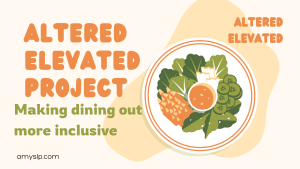Engaging the Senses with a Single Bite
Mindful eating is a powerful tool, especially when navigating dysphagia. It helps build awareness of the swallowing process, reduces anxiety around meals, and strengthens the mind-muscle connection. This guided activity will help you focus on the sensory experience of eating, using a single small bite of a food that is in your “safe zone”.
Choosing Your Food
Please choose one of the following options depending on where you find your current needs
● ///For Pureed (IDDSI Level PU4): A small spoonful of a smooth fruit puree (e.g., banana, applesauce, yogurt, or thickened juice).
● ///For Minced & Moist (IDDSI Level MM5): A soft, moist piece of banana or well-mashed avocado.
● ///For Soft & Bite-Sized (IDDSI Level SB6): A small, tender, moist piece of peeled fruit (e.g., a slice of very ripe pear or soft peach).
● ///For Regular (IDDSI Level EC7): A small piece of a soft food you enjoy, such as a piece of a ripe berry or smooth cheese.
Find a quiet space where you can focus fully on this moment. Sit comfortably and take a deep breath before you begin.
Step 1: Observing the Bite
Before placing the food in your mouth, simply look at it.
● Notice its shape, size, and color.
● How does the light reflect on its surface?
● Is there any moisture or texture you can see?
Now, bring it closer to your nose and take a gentle inhale.
● What does it smell like?
● Is the scent subtle or strong?
● Does it trigger any memories or expectations about taste?
Step 2: Feeling the Texture
Gently press the food between your fingers or tongue.
● How does it feel? Smooth, soft, firm, or yielding?
● Does it change shape easily or hold its form?
● If using a puree, how does the spoon feel as it glides through
Step 3: Bringing Awareness to the Mouth
Place the bite in your mouth, but don’t chew or swallow immediately.
● How does it feel on your tongue?
● Can you notice your salivary glands responding?
● Is the flavor immediately strong, or does it build?
Slowly begin to move the food around your mouth, noticing how your tongue and muscles engage.
● If chewing is required, how does it feel as the food softens?
● If it’s a puree, how does it spread across your tongue?
● Pay attention to how your body prepares for the swallow—is there a moment where you naturally feel ready?
Step 4: The Swallow
When you’re ready, consciously swallow the bite and focus on how it moves through your throat.
● Do you notice your voice box (larynx) lifting?
● How does your body know the swallow is complete?
Take a moment to breathe.
● Do you feel any changes in your throat or breath?
● How do you feel about the experience?
Reflection & Check-In
This practice is not about “getting it right.” It’s about building awareness of your own swallowing process and understanding it, not fearing it.
Did you notice anything new about how you eat?
Were there moments in which you were feeling tension or anxiety? These are areas to share with your care team for creating strategies that support you through this phase.
When did you feel most in control of the eating experience? These are areas that you can start to add new challenges when you feel ready to expand your “safe zone”.
Why This Matters While Managing Dysphagia
For some people, fear of swallowing difficulties (pseudodysphagia) can increase muscle tension, making eating feel even harder. This meditation is a tool to slow down, tune in, and rebuild confidence in your ability to eat safely.
If you struggle with anxiety around swallowing, try this meditation at the beginning of meals with a familiar, safe food.
If you are working with an SLP or therapist, share any insights or difficulties you noticed, they can help adjust strategies to make eating easier. If certain textures or sensations trigger discomfort, explore which parts of the process feel manageable and where support might be needed.
Bringing awareness to something automatic—like swallowing—can feel strange at first, but the more you practice, the more you will understand your own body’s cues. Each mindful bite is an opportunity to build trust in your ability to nourish yourself, safely and comfortably.



